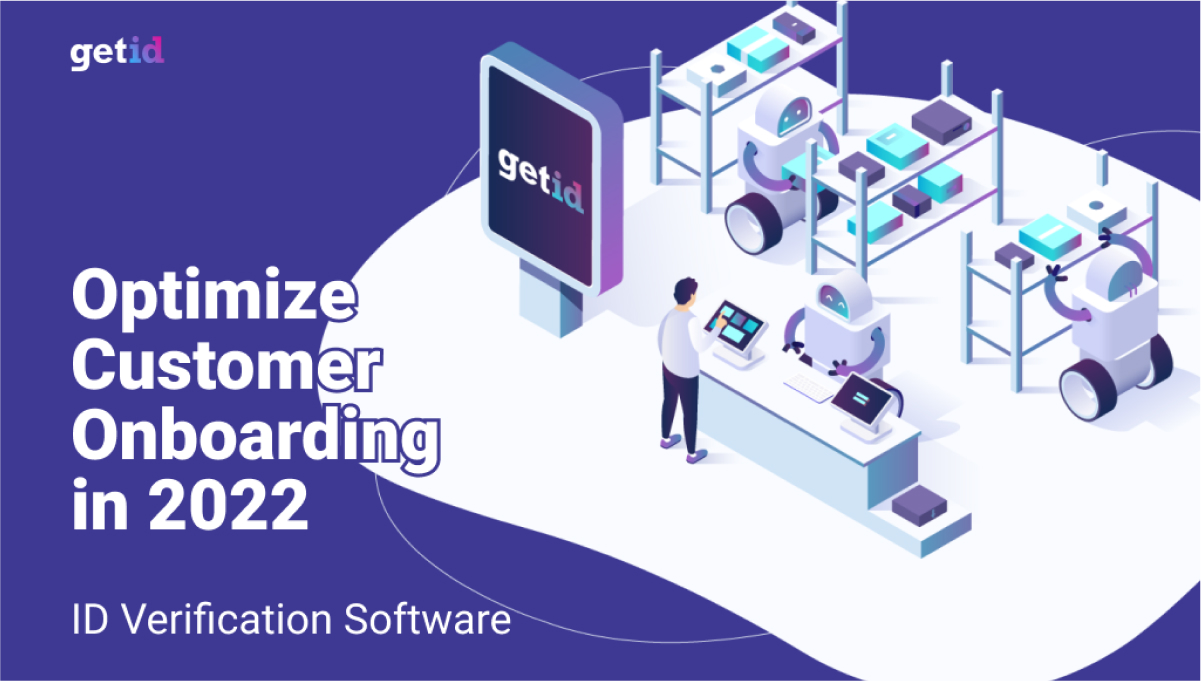
ID Verification Software: Optimize Customer Onboarding in 2023
22 Jan 2023
ID verification software is a combination of all the knowledge, experience and KYC verification acquired in the industry within the past 20 years. All that combined into an interconnected algorithm, that, due to a modern and dynamic technology, optimizes the onboarding process and reduces the amount of manual labor and human errors, unnecessary bustling and volume paperwork.
Introduction
Upon the arrival of the digital era the majority of financial institutions and organisations have moved into the online space, which, at the beginning, was a messy and unregulated environment. Since the online environment enabled people to stay anonymous, it enabled them to carry out all sorts of fraudulent activities: creating fake accounts and online identities, various credit card scams, money laundering. For many businesses, customer onboarding online has become a troublesome process, as they were unable to distinguish bad customers from the good ones. Consequently, it increased the friction in the onboarding process, resulting in revenue loss. As time went on, regulations and laws have caught up with the evolution of the online world. As a result, financial organisations have become obliged to comply with the new laws and regulations. This, in turn, has led to the need of ID verification software, so online businesses would be able to optimize the customer onboarding process and stay compliant.
When it comes to customer onboarding procedures, studies show that the time and money being spent by financial institutions and service providers is rocketing. With Know Your Customer (KYC), Anti-Money Laundering (AML), and data management regulations tightening, companies across the globe are struggling to keep up with the sheer volume of work needed to handle customer onboarding effectively.
Not only is regulation becoming stricter, creating a higher demand for identity verification services, but traditional manual ID verification processes are also highly ineffective. This means financial institutions and service providers are not only spending more time and money to access these services more often, but are also a slave to the inaccurate, taxing, and disjointed manual processing system. As regulations are only going to become more stringent, it’s in the best interest of every company to consider more effective routes to identity verification to optimize onboarding in 2023. Thankfully, GetID’s automated identity verification software offers everything needed to enhance onboarding. By leveraging GetID’s highly secure identity verification solutions, financial institutions and service providers can now save considerable time and money, while eliminating inaccuracies, protecting against fraud, and staying compliant with current and future regulations.
Here’s a guide to how GetID’s identity verification software can optimize onboarding for your company in 2023.
How Does ID Verification Work?

To kick off, let’s consider how ID verification works and why current identity verification solutions cause friction in the onboarding process.
For financial institutions (and an increasing number of other businesses) AML regulations are mandatory by law. These companies need to do everything in their power to help protect against money laundering and financial crime, due to the detrimental impact it can have on economies and financial structures. Part of this procedure is knowing exactly who your customers are, referred to, officially, as KYC and Customer Due Diligence (CDD).
In the onboarding process, this involves verifying that customers are who they say they are, and running checks against databases of potentially harmful or politically exposed applicants. Further CDD processes involve monitoring transactions over time, along with risk assessments and auditing.
Focusing on the onboarding process, service providers need to verify the identity of customers applying for services. The current manual procedure for this involves gathering Personal Identifiable Information (PII), such as a customer’s full name, address, and date of birth, and comparing it against official documentation, such as a passport, utility bill, or driver’s license. For every application, this analysis is completed by a series of independent third-party verifiers, who manually assess the information (using humans) to confirm a person’s identity, before running it through the relevant databases.
As one can imagine, this procedure is extremely slow, highly error-prone, vulnerable to fraud, and very insecure. On top of this, rising regulations have caused an overload on the system, enabling verifiers and compliance officers to charge higher fees as their services are in short supply and high demand. All this is compounded by the fact that companies cannot keep up with ever-changing regulations, causing onboarding procedures to become outdated and non-compliant, leading to outrageous non-compliance fines and remediation costs.
The introduction of effective onboarding identity verification software has the power to smooth onboarding processes from here on out. GetID’s automated onboarding process removes the weak points in the system by providing instant access to customers’ verified digital IDs. This cuts out the need for third-party verifiers, speeding up the process, significantly reducing costs, eradicating human error, and guaranteeing compliance.
How Does ID Verification Software Save Money?
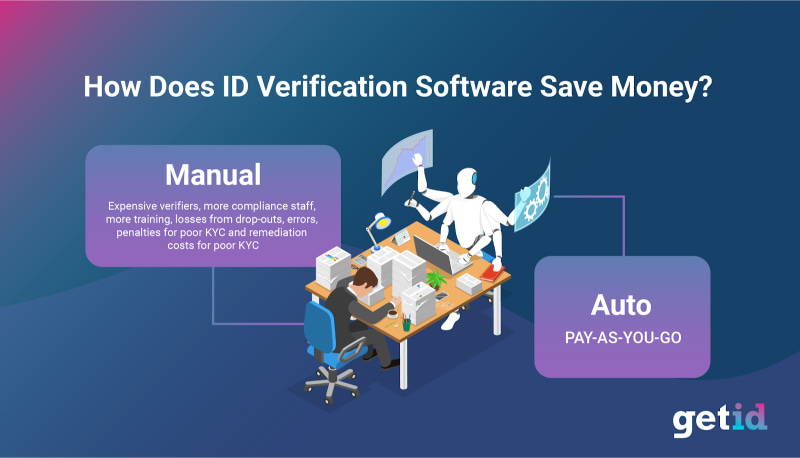
Studies show that companies are spending between $850,000 (for companies with less than $1 billion in assets) and $15.8 million (over $100 billion in assets) on AML compliance per year. The traditional manual KYC onboarding process is expensive for a number of reasons. ID verification software, such as GetID, has the power to do away with these costs.
Why Is Manual ID Verification so Costly?
Firstly, compliance staff and trustworthy third-party verifiers are in short supply and can, therefore, charge high fees. This is due to AML regulations sky-rocketing in recent years, creating a huge demand for these services. Not only does this cost companies more money for each individual onboarded customer, but it also increases outlay for staff training and employment, as internal compliance teams and procedures grow rapidly. Illustrating this, statistics show that in 2019, alone, compliance salaries jumped by 11%, and have been continuing to rise ever since. Companies like JPMorgan exemplify this, having had to add 5000 additional employees to their compliance team, spending an extra $1 billion a year.
On top of this, financial institutions and service providers are experiencing unprecedented losses due to friction in the KYC process, causing poor customer onboarding user experience (UX). Ballooning demand creates a backlog of applications, causing users to drop out before completing the application process. Poor customer onboarding UX and client management is said to be costing institutions in the region of $10 billion a year in lost revenue.
In addition to these inflating costs, companies that are struggling to maintain an appropriate level of regulatory compliance are feeling the full force of financial penalties from regulatory authorities. Studies show that US institutions were fined over $23 billion for poor AML and KYC procedures during the last 10 yeyars, with another $2 billion worth of penalties in 2019, alone.
How Does ID Verification Software Reduce Costs?
GetID identity verification software is a multi-layered stack of automated technologies that verify ID without the need for 3rd party verifiers.
Using biometric facial recognition software, liveness detection, optical character recognition, and autonomous database comparisons, GetID’s solution can automatically verify customers. Users only need to create a digital ID on the GetID system once, which is verified using these autonomous technologies. This digital identity verification certificate is now instantly accessible upon request to institutions that need to verify a potential customer’s ID. Any new regulations will trigger a notification to users to update their digital IDs as necessary.
In this sense, there is no longer a need for costly third-party verifiers and huge compliance teams, while costs associated with human-error and fraud are practically eliminated. Not only that, but the reduction in friction in the customer onboarding UX means fewer losses from customer dropout rates, while fully compliant software protects against non-compliance fines.
The benefits from the use of automated ID verification software of this nature can be seen in India. Having introduced the Aadhaar-based e-KYC system on a country-wide basis, ministers have declared that the average cost of customer verification has dropped from $15 to just $0.50.
How Does ID Verification Software Reduce Onboarding Delays?
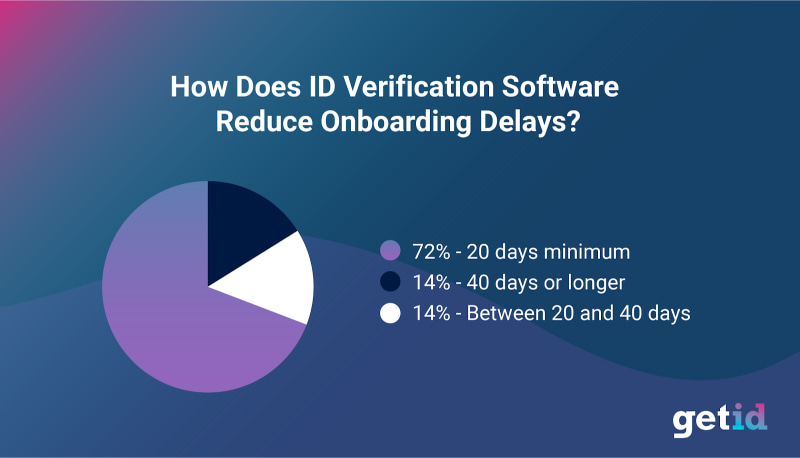
While onboarding wait times of up to 20 days are the expectation these days, a third of individuals and firms are experiencing even longer delays to their customer onboarding experience. Luckily, GetID provides a viable and effective identity verification solution to shorten the onboarding timeline.
Why Do Manual ID Verification Processes Delay Onboarding?
Elevated AML and KYC regulations have overburdened the system, causing huge backlogs with third-party verifiers. Not only are manual KYC processes extremely arduous and slow due to their paper-heavy nature, a short supply of compliance officers and intermediary verifiers means the onboarding process slows down even further.
In addition to this, the increased demand for financial (and other) services globally, means that more KYC checks and ID verification procedures are being performed than ever before. The workload for independent verifiers and compliance teams is through the roof.
The problem is magnified further by the human error inherent in a manual system, especially when compliance staff and verifiers are overworked. The correction of these inaccuracies adds yet more time to the process of onboarding customers, leading to worse drop-out rates. Studies demonstrate that poor data management processes increased onboarding time in over 80% of cases.
Take the wealth management industry, for example. With the vast majority of wealth management firms wrestling to keep onboarding processes below 4 weeks, over half of wealth managers are seriously worried about the impact of drop-out rates on future business. In fact, some studies even show that 14% of high-net-worth-individuals (HNWI) are experiencing onboarding processes that take up to 40 days or longer.
How Does GetID’s Automated ID Verification Software Speed Up Onboarding?
With 36% of financial institutions claiming losses due to slow onboarding, there’s a strong case for the need for far more efficient ID verification technologies to relieve the burden and speed up the process.
The Aadhaar-based e-KYC in India clearly shows how online identity verification software can reduce onboarding times, having reduced the ID verification process from more than five days down to seconds for Indian companies.
Moreover, Shahram Orandi, the Chief of the Information Access Division at the US National Institute of Standards and Technology (NIST) has highlighted the success of ID verification software for airport security. He notes that “at airports, the system can [now] respond in seven to 10 seconds.” He goes on to add that “every second you save on a single passenger translates into about a day’s worth of labor each day for each year”, pressing the point that automated ID verification software not only saves time but also money while enabling human resources to be redirected to more high-risk dangers.
Without the need for third-party verifiers, GetID’s automated identity verification software enables customers to create and verify their ID in minutes. In turn, these autonomous technologies allow service providers to access clients’ verified digital IDs in seconds. This speeds up ID verification and KYC processes, easing friction in onboarding and reducing drop-out rates.
How Does ID Verification Software Eliminate Inaccuracies?
Manual onboarding procedures are littered with inaccuracies as PII information and official documents are passed from verifier to verifier. From data entry mistakes to human errors in judgment, the constant changing of hands and the disjointed process can lead to security problems, delays, and increased costs. Automated ID verification software eradicates these errors by creating a more streamlined onboarding workflow that takes out the need for human interaction and a continuous ‘bandying about’ of sensitive customer data.
Why Are Manual ID Processes So Error-Prone?
The majority of manual onboarding processes require a lengthy process of physical paperwork and hand-typed spreadsheets. This manual process is carried out by humans and is often disjointed and spread across various different organizations and third-party verification companies. According to the Global Head of Corporate and Institutional Banking at Fernego, Greg Watson, this significantly increases the risk of misplaced or misentered information or delays in the transference of documentation from one party to another. Lost or misreported data, combined with outdated technologies and efficient workflows, show that human error is costing financial institutions billions each year.
Equally, mistakes are such a regular occurrence in manual processing, with even the most experienced analysts making mistakes, that quality review teams are necessary. This not only delays the process but also adds yet more costs to onboarding.
Take the investment industry. The Investment Industry Regulatory Organization of Canada (IIROC) claims that over 50% of complaints about investment problems are related to unsuitable investments, where inaccurate or outdated KYC data has been used.
How Can GetID’s ID Verification Software Eliminate Human Error?
By automating ID verification procedures, personal data entry only occurs once: when a customer first creates a digital ID. This significantly cuts back the chance of data being entered wrongly. With automated ID verification software, data is no longer passed from organization to organization, eliminating the weak spots in the workflow. Instead, a system verifies the data using biometric scanners and liveness detection, shortening the process and taking out the need for humans. Without people mistyping data in spreadsheets or misplacing documents, human error becomes a thing of the past.
With that, costs and time associated with human error and quality review checks are sharply reduced.
How Does ID Verification Software Reduce Fraud?
While various types of fraud are on the rise, application fraud and identity theft are increasing problems worldwide. Poor KYC measures, shoddy security protocols, and untrustworthy verification companies make manual onboarding a hotbed for fraud. By employing a multi-layered autonomous ID verification solution that employs next-generation technologies, GetID significantly diminishes the opportunity for fraud in the onboarding process.
Why Is Manual ID Verification so Vulnerable to Fraud?
Statistics show that new account fraud is increasing year on year. For fraudsters, manual KYC and ID verification processes present a wealth of opportunities for fraud in the lengthy workflow.
Stolen PII data and false photographs are a common way of committing application fraud and identity theft as hackers can access this information quite easily online. More worryingly, this sensitive data is also at risk from malicious actors within the operational workflow of KYC processing, as data is sent to a plethora of third-party verifiers all around the world. All it takes is one dishonest employee to steal that data and use it for themselves or sell it on.
While some companies have tried to employ biometric measures to help reduce fraud and add convenience to onboarding, biometric face match alone is not enough to deter fraudsters. In fact, a study by the University of North Carolina created 3D models of human heads using information and photographs found publicly on Facebook. Using a virtual reality system, the researchers found it relatively easy to spoof four well-known biometric face scanners 55 – 85% of the time.
In this sense, not only are manual ID verification processes vulnerable to fraud, so are poorly executed technologies used on their own.
How Does GetID Reduce Fraud Vulnerabilities?
GetID is an automated ID verification technology stack that deploys cutting-edge solutions in a multi-layered architecture. By combining various state-of-the-art technologies at once, GetID reduces the chance of fraud significantly; similar to employing several extremely tough safety nets simultaneously.
Especially poignant is the use of ‘liveness detection’. After the optical character recognition pulls out and verifies written data, and the biometric face match technology scans and confirms a customer’s face, liveness detection is deployed. This technology asks a customer to prove they are live in the moment by having them complete a task given there and then, such as smiling or raising eyebrows. This task cannot be predetermined, so fraudsters cannot use pre-recorded videos to try to trick this system. Having shown to be one of the most effective fraud prevention techniques of today, the NIST has declared liveness detection to be 99.7% effective against fraud.
In this sense, if you are seeking recommendations on ID verification software, GetID offers the ideal affordable solution for fraud prevention in ID verification.
How Does ID Verification Software Ensure Regulatory Compliance?
As technology use and data production increases along with the demand for services, compliance regulations are also tightening in an attempt to stem the risk of a tidal wave of financial crime. Manual processes are struggling to meet regulatory compliance due to sloppy procedures, human error, and slow operational development. GetID’s ID verification software easily meets all compliance regulations, with responsive workflows geared to meet all regulatory changes in the future.
Why Do Manual ID Verification Procedures Struggle to Stay Compliant?
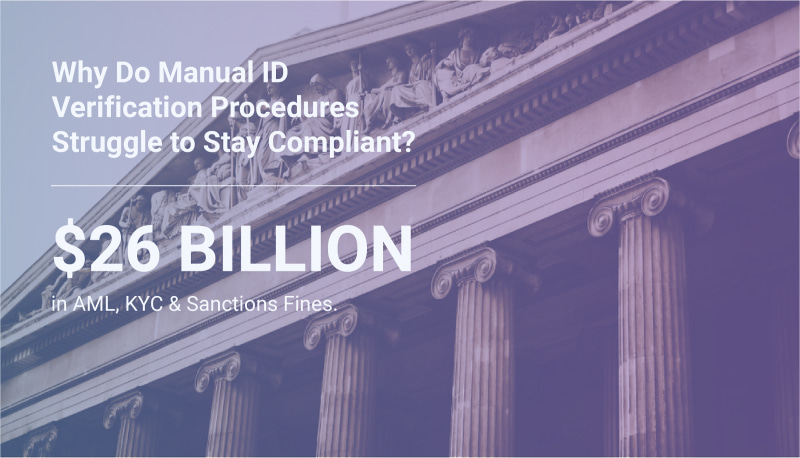
According to Phil Masterton, the Senior VP and MD of Investment Manager Services at investment giant, SEI, 80% of processes have errors or are defined as ‘not in good order’. Due to this, businesses are locked out of their accounts, and remediation steps are needed to remedy KYC and ID verification procedures to meet regulatory standards. Studies show that 55% of wealth managers are struggling with cross-border compliance, preventing onboarding altogether.
Disjointed operational workflows, security inefficiencies, increased demand, a shortage of staffing, and slow change management are all indicative of manual KYC and ID processing. While regulatory compliance is extremely strict, punishing non-compliant companies with unimaginable fines, the very nature of manual processing means these institutions are struggling to improve procedures to a high enough standard. According to Masterton, this is often because databases are inaccurate, communication is broken, and company AML policies are outdated.
How Can GetID’s ID Verification Software Help Companies Keep Up With Compliance Regulations?
With automated workflows, compliance teams no longer need to focus energy toward ID verification and customer analysis, and can instead direct their resources to improving and updating all AML and KYC policies.
Moreover, GetID’s autonomous software ensures that customers and companies are notified of compliance changes and can keep records up to date accordingly. This prevents errors in the system that later lead to large fines and the need for remediation. Unlike manual procedures that struggle with being one step behind, GetID’s system is designed to guarantee compliance for today’s rules and any regulatory changes in the future.
Conclusion
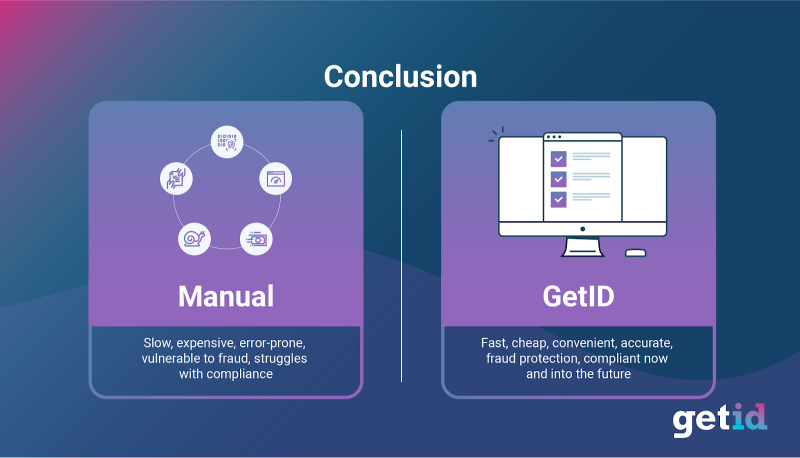
Manual ID verification procedures are disjointed, overburdened, vulnerable to interception by malicious actors, and outdated. Not only does this make them slow and costly, but it also puts these procedures at risk of fraudsters and leaves systems littered with errors. On top of this, service providers are being slammed with non-compliance penalties as they struggle to change AML/KYC policies fast enough to keep up-to-date with ever-changing regulations.
Luckily, GetID is paving the way to a smoother onboarding experience for both service providers and customers. Automated ID Verification software cuts out the need for third-party verifiers, which not only reduces onboarding times and costs, it also limits human-error and the opportunity for fraud. GetID’s state-of-the-art technology stack ensures that KYC and ID verification processes are accurate, updated, and regulatory compliant, now and into the future.
Reduce friction in your onboarding process for 2023 by rolling out GetID’s ID verification software. Offering your customers a far easier route to onboarding, you’ll take over the competition and enroll clients in seconds, for a fraction of the cost. Stay compliant with all future regulations by deploying GetID’s ID verification software, and optimize your onboarding procedures for 2023.
Contact us today to find out more.